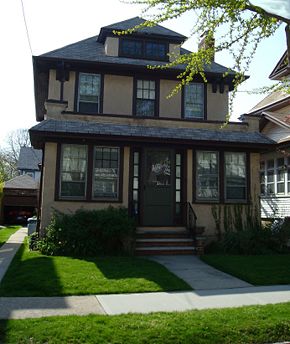Rising Real Estate Prices
From The Peopling of New York City
The more desirable and competitive an area becomes, the higher its demand, therefore the higher its housing prices. This basic economic principle is currently dictated by Flushing’s skyrocketing home values. Due to the rapid growth and “immigrant boom” (Smith) the town is experiencing, not to mention its extremely convenient location (“Real”), the act of buying a decent home in Flushing has, since the late 1990s (Roleke), become as unrealistic as buying one in Manhattan.
Because of “the Asian influx,” commercial property and house prices have gone up, making several of the once comfortably established non-Asian businessmen and inhabitants move out and take their businesses with them someplace else (Worsnop). Or, as Robert Lo, a Taiwanese real estate broker straightly puts it, “Flushing rents remain high because Oriental people keep moving in” (Deutsch).
There are some “long-time (European) shopkeepers” of the vicinity that are “openly hostile” about the real estate issue according to Smith and his interviewers. In fact, these residents readily rest the blame on Asians, regardless of worries about being politically incorrect, claiming that they have brought about soaring rent prices with their “heavy real estate investment” (Smith).
It is not as though all benefits resulting from the influx rests solely within the Asian population though. Besides those who came early to Flushing and earned sizable profit in purchasing and reselling real estate, scores of Asian-American families “of modest means” find also Flushing too pricey because of the increasing house values (Worsnop).
Lifetime Flushing resident and community leader, Jay Williams, shared that he attended a meeting for first-time Flushing homeowners upon purchasing his father’s house. He pointed out that the people conducting the meeting told the audience, “don’t even begin to look at a house for under $300,000.” It is these kinds of prices in the real estate market that justify William’s coined term for describing the situation Flushing’s low-income crowd is hit by, known as “the economic genocide.” After all, William’s flatly states, “there is no place for poor people in Flushing.”'
Other interviewed residents revealed that several religious and community institutions have been made into private homes or have been “replaced by more profitable land uses.” Anxiety about the demolition of once peaceful vicinities, which now bring in masses of noisy cars and people, has thus risen. Some residents have supported the motion of placing a moratorium on development so as to prevent Flushing from transforming into “another Seoul, Taipei, or Hong Kong,” which they declare to be of the most polluted and crowded cities in the world (Smith).
Future Trends
Based on the speculations drawn from the Downtown Flushing website, housing and retail growth will “likely continue” despite the unstable push for development because of “the existing balance of uses between residential, retail, and office” space (“Real”). The representatives of the site, including Mayor Bloomberg, assure that once the “projected growth trends” and demands for housing and retail are understood, then “it is clear that Downtown will need to grow beyond the traditional retail core” (“Real”).
